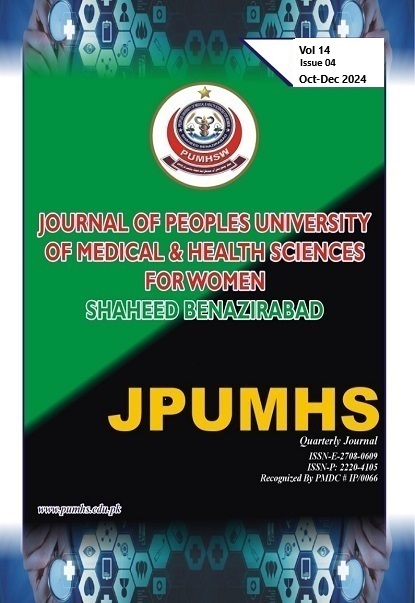OUTCOMES OF SURGICAL AND NON-SURGICAL MANAGEMENT OF SEVERE PANCREATITIS A CROSS-SECTIONAL STUDY AT PUMHS.
.JPUMHS;2024:14:04,124-131. http://doi.org/10.46536/jpumhs/2024/14.04.569
Keywords:
Severe acute pancreatitis, surgical intervention, non-surgical management, morbidity, mortality, complications, necrosectomy, gender differences, resource-limited settings.Abstract
BACKGROUND: Severe acute pancreatitis SAP is a life-threatening condition associated
with high morbidity and mortality, particularly in resource-limited settings. Surgical and non
surgical management strategies remain pivotal in SAP care, with limited data available in the
regional context. OBJECTIVE: This study aimed to compare the outcomes of surgical and
non-surgical management of SAP, including mortality, complications, and length of hospital
stay, at Peoples University of Medical and Health Sciences PUMHS, Nawabshah.
METHODS: A cross-sectional study was conducted, including 400 patients diagnosed with
SAP based on the revised Atlanta classification. Demographics, management type,
complications, mortality, and hospital stay data were analyzed. Statistical tests, including chi
square and logistic regression, were applied to determine associations and predictors of
outcomes. RESULTS: Of the 400 patients, 61.5% received non-surgical management, while
38.5% underwent surgical intervention. Mortality was significantly higher in the non-surgical
group 25% compared to the surgical group 12.5% p < 0.05, particularly among males.
Complications such as organ failure and infections were more common in non-surgical
patients 28.8% in males vs. 15.5% in females. Surgical management demonstrated improved
outcomes, with reduced mortality and comparable hospital stays. Disease severity scores
were critical predictors of mortality and prolonged recovery, while gender differences
influenced complication rates. CONCLUSION: Surgical management significantly improves
outcomes in SAP patients with severe complications. Early disease stratification, timely
interventions, and infrastructure development for minimally invasive techniques are essential
for optimizing SAP care in resource-limited settings.
Downloads
Downloads
Published
How to Cite
Issue
Section
License

This work is licensed under a Creative Commons Attribution-NoDerivatives 4.0 International License.




